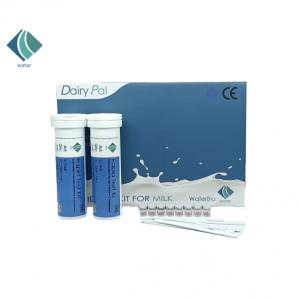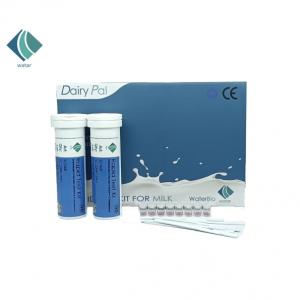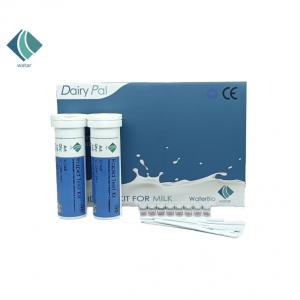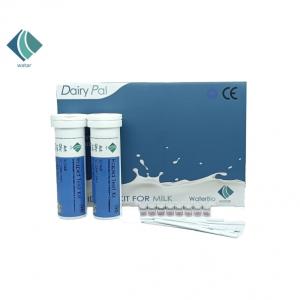SC105 Mycotoxin Aflatoxin M1 Rapid Test Kit(0.5ppb)
- Product Item : SC105
- Category: Single Test Kit
- Detection Time:10min(5min+5min)
- Detection Limit:0.5ppb
- Detection Temp:Room temperature or 25℃
- Shelf Life:1 year
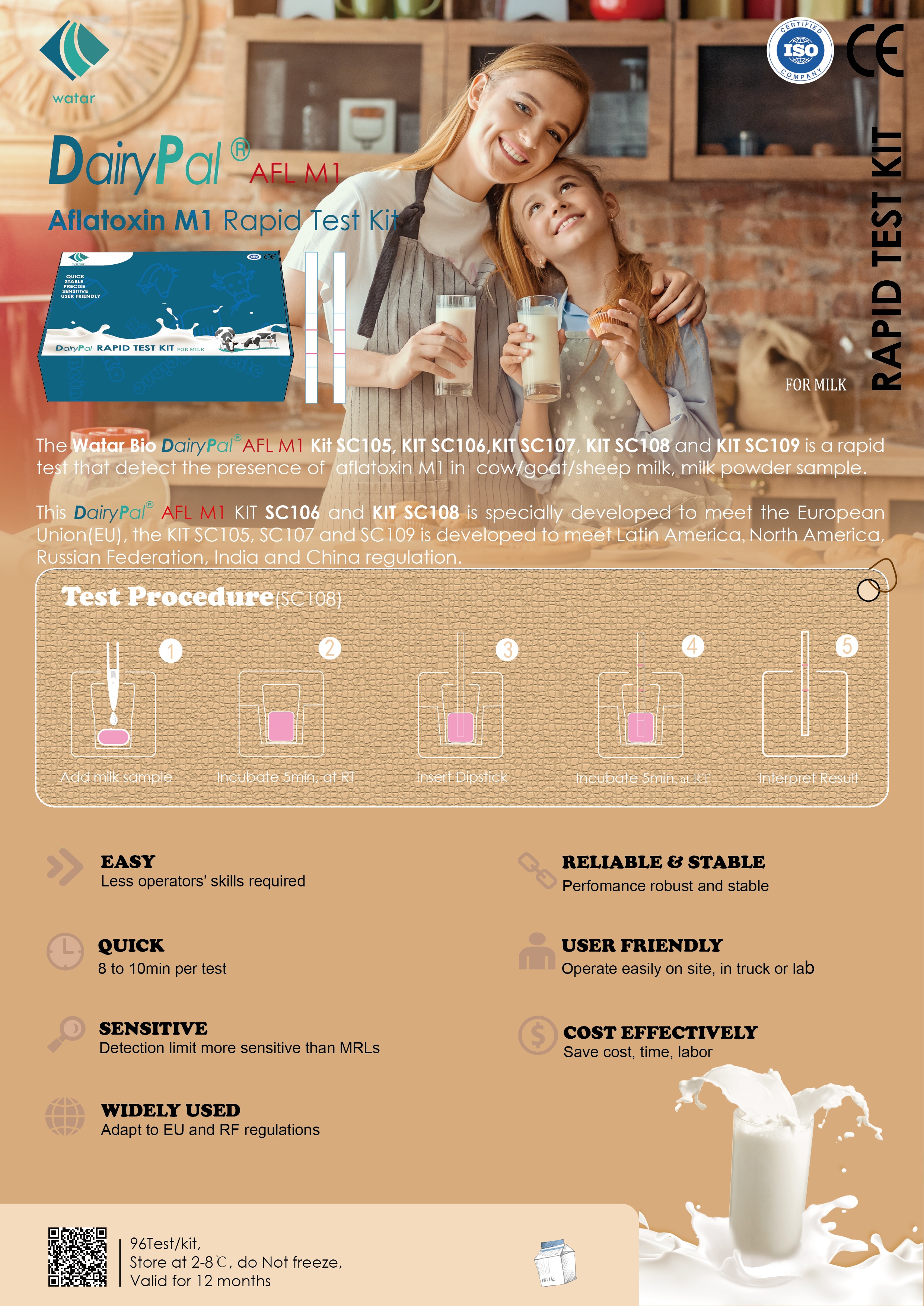
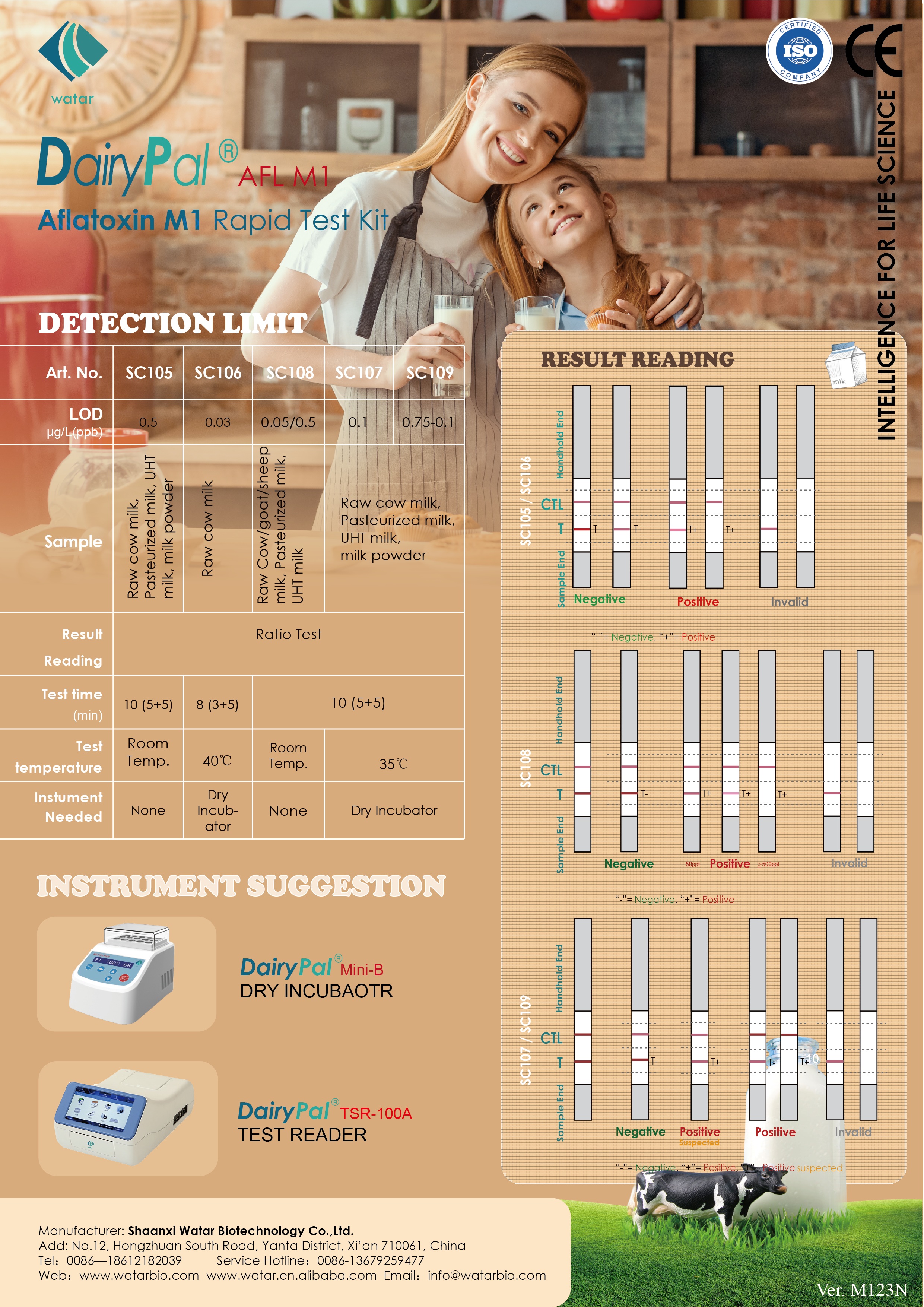
Aflatoxin M1 Rapid Test Kit(0.5ppb)
Rapid Test for the presence of Aflatoxin M1 in raw cow milk

BACKGROUND
Aflatoxin M1 is a chemical compound of the aflatoxin class, a group of mycotoxins produced by three species of Aspergillus - Aspergillus flavus, Aspergillus parasiticus, and the rare Aspergillus nomius - which contaminate plant and plant products.
Aspergillus flavus produces only B-type aflatoxins. Aflatoxin M1 is the hydroxylated metabolite of aflatoxin B1 and can be found in milk or milk products obtained from livestock that have ingested contaminated feed. The carcinogenic potency of aflatoxin M1 in sensitive species is about one order of magnitude less than that of aflatoxin B1. Aflatoxin M1 is usually considered to be a detoxication by-product of aflatoxin B1. The main sources of aflatoxins in feeds are peanut, meal, maize and cottonseed meal
According to the review conducted by the Dutch National Institute for Public Health and the Environment (RIVM) on behalf of the Food and Agriculture Organization (FAO) approximately 60 countries have set specific limits for aflatoxin M1. The European Union countries generally apply a maximum level of 0.05 μg/kg milk. Some countries in Africa, Asia and Latin America also propose this level. In contrast, the USA as well as some European and several Asian countries accept a maximum level of 0.5μg/kg aflatoxin M1 in milk, which is also the harmonized MERCOSUR limit applied in Latin America. The 0.5μg/kg limit for aflatoxin M1.
APPLICATIONS
The Watarbio AFL M1 is a rapid test that detect simultaneously the presence of the Aflatoxin M1 molecules in raw cow milk, Pasteurized milk, UHT milk, milk powder(dissolve the milk powder with water in volume ration of 1:9) sample.
LIMIT OF DETECTION (LOD)
0.5 μg/L(ppb)
CONTENTS
l 96Tests: 12 tubes each with 1 strip of 8 reagent microwells and 8 dipsticks
l 1 Negative Control
l 1 Positive Control
l 1 Mini pipette
l 1 Microwell holder
l 100pcs Disposable plastic pipette
l 1 Kit insert
TEST PROCEDURE
1. Read the instruction attentively, choose a clean and dry place to perform the test, wash and dry your hands before starting.
2. Take the kit out of the fridge and wait until the temperature of the reagents reaches the ambient temperature.
3. Calculate how many milk sample will be tested and mark the sample tubes to identify. The milk samples should be fully liquid without any clots or deposition, the ideal temperature of milk sample is between 4 to 20℃.
4. Take the tubes required from the kit package, take out as many micro-wells and dipsticks as the milk samples to be tested, and make proper marks to match the milk sample.
l To open a dipsticks tube, press the safety ring down, take off the ring and get the tube cap off with your thumb.
l Recover the cap tightly after taking out the required micro-wells and dipsticks.
l Empty one test tube then open another one.
l Keep the unused micro-well caps tightly sealed. Do NOT tear off the strip of 8 microwell caps.
l Use the exposed dipsticks in 1 hour.
5. Place the required numbers of the mircrowells in the dry incubator, transfer 200ul of the milk samples into the microwells, inject and reject the milk sample for 5 times consecutively to homogenize the lyophilized reagent and milk sample.
l Dip the end of the plastic pipette(or watar Mini pipette) tips into the milk and slowly releases the sucker. When the sucker is back into its initial position, transfer the 200µl of milk into the reagents, by slowly pushing the sucker down to the bottom.
6. Start the timer to incubate for 5 minutes at ambient temperature(around 25℃);
l During the incubation, The receptors will detect the presence of the analyte in the milk sample. The reaction will take 5 minutes.
7. Dip the dipsticks into the micro-wells with the "Sample End" down side to the bottom.
8. Start the timer to incubate for 5 minutes at ambient temperature(around 25℃) again.
9. Then take out the dipsticks and place them laterally in a dry clean place, peel off the sample pad, interpret the result.
l Use a clean nipper(or new pipette tip) to scrape gently and slowly the sample pad.
l The peeling off of the sample pad will stop the ongoing reaction of the receptors.
l File the used sample pad peeled off dipsticks if necessary.
RESULTS INTERPRETATION
The dipsticks are embodied with 2 lines, Control line and Test line, which are briefly expressed as “CTL” and “T”. The test results will be determined by the color density of the lines. The following diagram describes the result identification.
l NEGATIVE: Line CTL and Line T both are visible, Line T is stronger than or equal to Line CTL. which means that, the milk sample contains the aflatoxin M1 fewer than value given in the table.
l POSITIVE: Line CTL is visible, Line T is invisible or weaker than Line CTL, which means that the milk sample contains the aflatoxin M1 more than detection limit.
CATEGORIES
LATEST NEWS
CONTACT US
Mobile:+86-18612182039
Tel:+86-029-85274126
Whatsapp:+8618612182039
Email:info@watarbio.com
Add:No. 12, Hongzhuan South Road, Yanta District, Xi’an 710061, China

.108.3-1.jpg)
.108.3-2.jpg)
.108.3-3.jpg)
